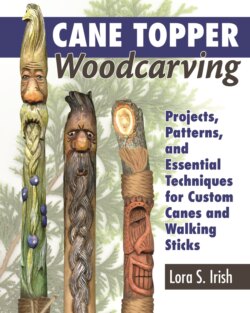Читать книгу Cane Topper Woodcarving - Lora S. Irish - Страница 12
На сайте Литреса книга снята с продажи.
Storage and Drying
ОглавлениеWhen it comes to storage and drying, walking stick carvers tend to have their own personal techniques. If you belong to a carving club or have access to online message boards for your region, take the time to ask your local carvers what works best for them. They know your climate and your tree species, so their advice is well worth discovering.
As a general rule of thumb, fresh-cut wood is dried for one year for each 1" (2.5cm) of thickness. This means that a 4" (10cm) slab of newly cut wood will take about four years to properly dry for woodworking. But since we are working with cut branches that are usually 2" (5cm) or less in diameter, most cut sticks only need about six weeks before they are ready to work as green wood sticks. Because we are cutting our staffs in the fall and winter seasons, the sap content tends to be lower in the tree than it would be during warm weather. Your fall-cut sticks have less sap and moisture that needs to escape from the wood. The moisture also has less wood surface from which to escape, so small-width sticks dry to a working moisture level quicker than larger, thicker sticks. Walking stick saplings cut in the early fall are well ready to work by the beginning of the new year. These green wood–worked sticks will continue to dry over time after you have created your walking stick without affecting your connecting joints.
I bundle my sticks in groups of 10 to 12 using¼" (0.5cm) nylon rope. The rope is looped around the wide end—the root end—of the stick, with the rope ends tied into a hanging loop. The group is then hung from the rafters of an unheated shed or under the outside roof overhang of the shed. I allow about 6" (15cm) to 8" (20.5cm) of space between groups for air circulation. This keeps the sticks out of direct sunlight and rain.
